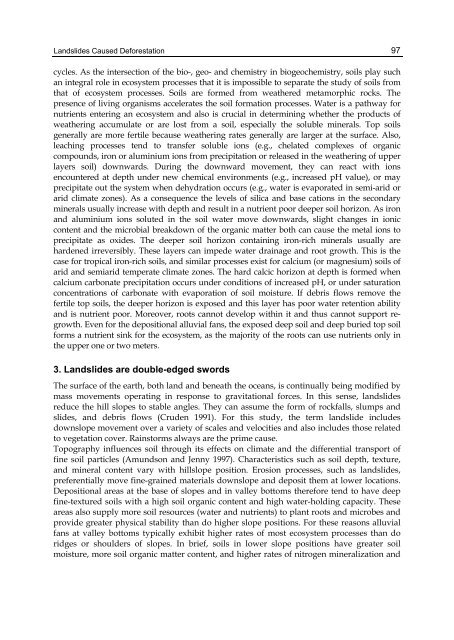DEFORESTATION AROUND THE WORLD - India Environment Portal
DEFORESTATION AROUND THE WORLD - India Environment Portal
DEFORESTATION AROUND THE WORLD - India Environment Portal
You also want an ePaper? Increase the reach of your titles
YUMPU automatically turns print PDFs into web optimized ePapers that Google loves.
Landslides Caused Deforestation<br />
cycles. As the intersection of the bio-, geo- and chemistry in biogeochemistry, soils play such<br />
an integral role in ecosystem processes that it is impossible to separate the study of soils from<br />
that of ecosystem processes. Soils are formed from weathered metamorphic rocks. The<br />
presence of living organisms accelerates the soil formation processes. Water is a pathway for<br />
nutrients entering an ecosystem and also is crucial in determining whether the products of<br />
weathering accumulate or are lost from a soil, especially the soluble minerals. Top soils<br />
generally are more fertile because weathering rates generally are larger at the surface. Also,<br />
leaching processes tend to transfer soluble ions (e.g., chelated complexes of organic<br />
compounds, iron or aluminium ions from precipitation or released in the weathering of upper<br />
layers soil) downwards. During the downward movement, they can react with ions<br />
encountered at depth under new chemical environments (e.g., increased pH value), or may<br />
precipitate out the system when dehydration occurs (e.g., water is evaporated in semi-arid or<br />
arid climate zones). As a consequence the levels of silica and base cations in the secondary<br />
minerals usually increase with depth and result in a nutrient poor deeper soil horizon. As iron<br />
and aluminium ions soluted in the soil water move downwards, slight changes in ionic<br />
content and the microbial breakdown of the organic matter both can cause the metal ions to<br />
precipitate as oxides. The deeper soil horizon containing iron-rich minerals usually are<br />
hardened irreversibly. These layers can impede water drainage and root growth. This is the<br />
case for tropical iron-rich soils, and similar processes exist for calcium (or magnesium) soils of<br />
arid and semiarid temperate climate zones. The hard calcic horizon at depth is formed when<br />
calcium carbonate precipitation occurs under conditions of increased pH, or under saturation<br />
concentrations of carbonate with evaporation of soil moisture. If debris flows remove the<br />
fertile top soils, the deeper horizon is exposed and this layer has poor water retention ability<br />
and is nutrient poor. Moreover, roots cannot develop within it and thus cannot support regrowth.<br />
Even for the depositional alluvial fans, the exposed deep soil and deep buried top soil<br />
forms a nutrient sink for the ecosystem, as the majority of the roots can use nutrients only in<br />
the upper one or two meters.<br />
3. Landslides are double-edged swords<br />
The surface of the earth, both land and beneath the oceans, is continually being modified by<br />
mass movements operating in response to gravitational forces. In this sense, landslides<br />
reduce the hill slopes to stable angles. They can assume the form of rockfalls, slumps and<br />
slides, and debris flows (Cruden 1991). For this study, the term landslide includes<br />
downslope movement over a variety of scales and velocities and also includes those related<br />
to vegetation cover. Rainstorms always are the prime cause.<br />
Topography influences soil through its effects on climate and the differential transport of<br />
fine soil particles (Amundson and Jenny 1997). Characteristics such as soil depth, texture,<br />
and mineral content vary with hillslope position. Erosion processes, such as landslides,<br />
preferentially move fine-grained materials downslope and deposit them at lower locations.<br />
Depositional areas at the base of slopes and in valley bottoms therefore tend to have deep<br />
fine-textured soils with a high soil organic content and high water-holding capacity. These<br />
areas also supply more soil resources (water and nutrients) to plant roots and microbes and<br />
provide greater physical stability than do higher slope positions. For these reasons alluvial<br />
fans at valley bottoms typically exhibit higher rates of most ecosystem processes than do<br />
ridges or shoulders of slopes. In brief, soils in lower slope positions have greater soil<br />
moisture, more soil organic matter content, and higher rates of nitrogen mineralization and<br />
97

















